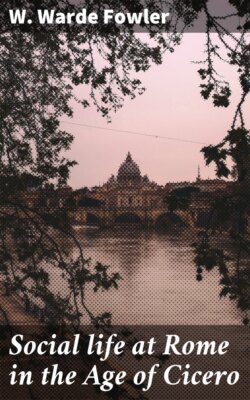Social life at Rome in the Age of Cicero

Реклама. ООО «ЛитРес», ИНН: 7719571260.
Оглавление
W. Warde Fowler. Social life at Rome in the Age of Cicero
Social life at Rome in the Age of Cicero
Table of Contents
CHAPTER I. TOPOGRAPHICAL
CHAPTER II. THE LOWER POPULATION
CHAPTER III. THE MEN OF BUSINESS AND THEIR METHODS
CHAPTER IV. THE GOVERNING ARISTOCRACY
CHAPTER V. MARRIAGE AND THE ROMAN LADY
CHAPTER VI. THE EDUCATION OF THE UPPER CLASSES
CHAPTER VII. THE SLAVE POPULATION
CHAPTER VIII. THE HOUSE OF THE RICH MAN IN TOWN AND COUNTRY
CHAPTER IX. THE DAILY LIFE OF THE WELL-TO-DO
CHAPTER X. HOLIDAYS AND PUBLIC AMUSEMENTS
CHAPTER XI. RELIGION
EPILOGUE. INDEX. ILLUSTRATIONS
PLAN OF HOUSE OF THE SILVER WEDDING AT POMPEII. MAP TO ILLUSTRATE THE POSITION OF CICERO'S VILLAS. PLAN OF THE VILLA OF DIOMEDES AT POMPEII. PLAN OF A TRICLINIUM. MAP
CHAPTER I
TOPOGRAPHICAL
CHAPTER II
THE LOWER POPULATION (PLEBS URBANA)
CHAPTER III
THE MEN OF BUSINESS AND THEIR METHODS
CHAPTER IV
THE GOVERNING ARISTOCRACY
CHAPTER V
MARRIAGE: AND THE ROMAN LADY
CATULL. 85
CHAPTER VI
THE EDUCATION OF THE UPPER CLASSES
CHAPTER VII
THE SLAVE POPULATION
CHAPTER VIII
THE HOUSE OF THE RICH MAN, IN TOWN AND COUNTRY
CHAPTER IX
THE DAILY LIFE OF THE WELL-TO-DO
PLAN OF A TRICLINIUM
CHAPTER X
HOLIDAYS AND AMUSEMENTS
CHAPTER XI
RELIGION
EPILOGUE
INDEX
THE END
Отрывок из книги
W. Warde Fowler
Published by Good Press, 2019
.....
We might go direct to the great Forum, up the Velabrum, or valley (once a marsh), right in front of us between the Capitol on the left and the Palatine on the right. But as we look in the latter direction, we are attracted by a long low erection almost filling the space between the Palatine and the Aventine, and turning in that direction we find ourselves at the lower end of the Circus Maximus, which as yet is the chief place of amusement of the Roman people. Two famous shrines, one at each end of it, remind us that we are on historic ground. At the end where we stand, and where are the carceres, the starting-point for the competing chariots, was the Ara maxima of Hercules, which prompted Evander to tell the tale of Cacus to his guest; at the other end was the subterranean altar of Consus the harvest-god, with which was connected another tale, that of the rape of the Sabines. All the associations of this quarter point to the agricultural character of the early Romans; both cattle and harvesting have their appropriate myth. But nothing is visible here now, except the pretty little round temple of a later date, which is believed to have been that of Portunus, the god of the landing-place from the river.[20]
The Circus, some six hundred yards long, at the time of Cicero was still mainly a wooden erection in the form of a long parallelogram, with shops or booths sheltering under its sides; we shall visit it again when dealing with the public entertainments.[21] Above it on the right is the Aventine hill, a densely populated quarter of the lower classes, crowned with the famous temple of Diana, a deity specially connected with the plebs.[22] The Clivus Patricius led up to this temple; down this slope, on the last day of his life, Gaius Gracchus had hurried, to cross the river and meet his murderers in the grove of Furrina, of which the site has lately been discovered. If we were to ascend it we should see, on the river-bank below and beyond it, the warehouses and granaries for storing the corn for the city's food-supply, which Gracchus had been the first to extend and organise.
.....